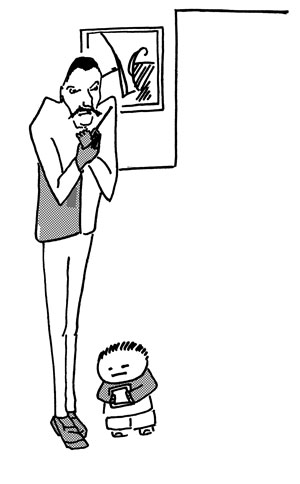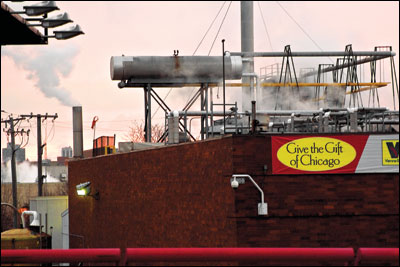Chicago writers duke it out over the direction of art criticism
By Whitney Stoepel
 “One Very Big Thumbs Down: Balcony closed, idiot floodgates open,” declared Clarence Page in the Chicago Tribune on April 15. “Good critics are an endangered species … Blame the usual suspect, the Internet. Just as it has put book, record, and video stores out of business, the Web also is grinding away at the very notion that critics should be respected for credentials and experience that show they actually know what they’re talking about.”
“One Very Big Thumbs Down: Balcony closed, idiot floodgates open,” declared Clarence Page in the Chicago Tribune on April 15. “Good critics are an endangered species … Blame the usual suspect, the Internet. Just as it has put book, record, and video stores out of business, the Web also is grinding away at the very notion that critics should be respected for credentials and experience that show they actually know what they’re talking about.”
This proclamation comes close to the one-year anniversary of the Tribune firing Alan Artner, the paper’s only staff art critic, who was let go in April of 2008.
This example alone sums up the ire, resentment and self-righteousness that has colored heated debates around the state of art criticism over the past several months. It’s a debate that has been particularly virulent here in Chicago; local writers are fired up over the increasing shift to web-based art writing.
So does this shift in media spell out doom for the industry, as Page would have it?
Those who have had a long and established career in criticism tend to see grass-roots, new media art critics as a threat to their livelihood. In an interview with F, Chicago artist and critic Erik Wenzel spoke to this frustration, stating, “No one has a background in art … as an artist [or] as an art historian. That’s not necessarily a bad thing, but there seems to be this assumption that anyone can just write about it.”
But is the older generation of culture commentators digging its own grave? In March, Newcity ran a series of articles that discussed the egalitarian shift in art and cultural criticism. In the article “What (Editorial) Obesity Hath Wrought,” Michael Nagrant defends the new generation of critics, joking, “Newspaper columnists and editorial pages deriding the rise of citizen or social media-based criticism sound like a grandfather telling his grandson he walked uphill both ways to and from school every day ducking gunfire and a blinding rainstorm.”
Nagrant believes that old media (i.e., newspapers, or art magazines) are at fault for the proliferation of criticism in the blogosphere, because they didn’t place enough importance on the writers when they implemented “top-heavy editorial hierarchies.”
For Nagrant, these complaints are symptoms of a self-induced victimization. At the height of this “crisis of criticism,” many have made themselves appear bitter and outdated because they played by a certain set of rules that the newer, successful writers proudly flout.
On the other hand, Newcity art editor Jason Foumberg’s package of articles published online in March, “The State of the (Visual) Art,” muses on how the metamorphosis of criticism is perhaps sacrificing quality. The Internet has catapulted art criticism into hyper speed, meaning less editing and less in-depth, critical analysis.
He quotes Chicago Art Magazine publisher Kathryn Born, who says trying to find the time and money for editors is “like organizing the kitchen cupboards while some dude bleeds to death in the living room … We publish two unedited articles each day. It would be nice to have someone look them over, but we just don’t have the money.”
Foumberg’s comment set off a ripple effect throughout the Chicago art scene. Former Dogmatic Gallery owner and blogger Michael S. Thomas posted a diatribe against Born on his blog, Stagnant Vowels: “At her site I should expect to see something different and substantive, something bereft of the flabbiness that she decries,” he writes. “Instead, it’s riddled with descriptive adjective-laden snot, too fearful of pronouncing meaning to extract either profundity or quality.” The argument continued with Claudine Ise at Bad at Sports, whose blog post on March 26 was titled, “Hot (Okay Maybe Lukewarm at the Moment) Topic Alert: The Crisis in Art Criticism.”
The personal, even spiteful tone of these squabbles only goes to support traditional complaints that new media criticism is hotheaded and amateurish. But these tensions aren’t just the stuff of squabbles in the blogosphere; they are also playing out institutionally.
The conception of SAIC’s M.A. in New Arts Journalism (NAJ) program is a perfect example. The need for such a program is described in the SAIC catalog: “In a rapidly changing media environment, there’s a pressing need for skilled individuals who can think and write about art and design with insight and versatility. The journalistic forums in which art is discussed are changing as the very audience for this content is expanding and diversifying.”
Although the department is emphasizing new media, the program is still caught in between the new and the traditional. Most NAJ professors are veterans of old media, experts who have been published in highly regarded publications such as ArtForum, Art in America, and the Chicago Tribune. But the program also requires students to take courses on blogging, a requirement that feels oxymoronic as it forces students to pay roughly $5,000 to learn how to use free programs.
In the battle over the future of criticism, maybe the emphasis is too much on the medium. Perhaps it would be more constructive for everyone involved if we put our focus back on the art of the writing.
Marshall McLuhan quotes General David Sarnoff in his landmark “The Medium is the Message”: “We are too prone to making technological instruments the scapegoats for the sins of those who wield them. The products of modern science are not in themselves good or bad; it is the way they are used that determines their value.”
Given the state of the publishing industry in general, the shift to publishing more and more art criticism on the web is inevitable. The one thing all involved in the argument can agree on is that criticism itself is essential to our experience of contemporary art, and that won’t change whether we read the criticism on a page or on a screen.
The so-called democratization of criticism won’t put highly skilled and qualified critics out of business, but will add to the dialogue. Once the dust from the debate starts to settle, the strong and qualified writers will stand out from the mass of voices.
As Foumberg declared, “The need for expertise, and good writing, will resurface. The public should demand it.”







